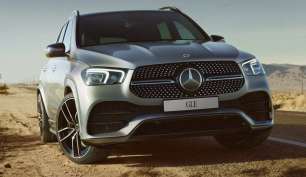With its hefty 2575kg kerb weight and 3310kg GVM, our test vehicle has a 735kg payload rating which is modest compared to numerous turbo-diesel class rivals.
It’s also rated to tow up to the class-benchmark 3500kg of braked trailer, but with its 6555kg GCM rating (or how much it can legally carry and tow at the same time) that would require a 255kg reduction in payload (from 735kg to 480kg) to avoid exceeding the GCM.
While it’s unlikely Alpha Hybrid owners would need to tow at the 3500kg maximum, it’s important to be aware of these numbers if the need arises, as that 480kg could be used up by a crew of five adults before you could load any luggage.
The load tub is 500mm deep and almost square given its 1500mm length and 1520mm width. With 1100mm between the rear wheel-housings, it won’t fit a standard 1165mm-square Aussie pallet but will take Euro pallets.
It’s protected by a spray-on tub-liner and there are four fixed load-anchorage points. However, the front two are located near the top of the side-walls and the rears are mounted at mid-height, both of which are not ideal for securing low-profile loads (anchorage points just above floor level are ideal).
The load tub is accessed through a two-way tailgate, which with the push of a button can open as either a conventional one-piece tailgate to a horizontal position, or can split 60/40 into a pair of doors that swing open from each side to allow closer access to the load floor. Only time will tell if this two-way design is robust enough for regular workhorse duties.
There are assist handles on the A and B pillars and ample room for front seat occupants, along with generous rear seat headroom despite the presence of a large sunroof which can often compromise this space.
The cabin's rear floor is predominantly flat with the welcome absence of a large transmission tunnel, allowing centre passengers the luxury of being able to put their feet together behind the centre console. However, shoulder-room is tight for three large adults, so two would be preferable for long trips.
Given I’m 186cm tall, there’s also sufficient kneeroom when sitting behind the driver’s seat in my position. And unusual rear seat luxury in a ute is the powered backrest recline for the two outer seating positions, although kneeroom is reduced as the base cushions must slide forward to enable this function.
Storage for the driver and front passenger includes a large-bottle holder and bin in the base of each door. There’s also a large glove box and overhead glasses holder, plus a handy pull-out compartment in the lower dash to the right of the steering column for the driver.
The centre console has a wireless phone-charging pad up front and a large storage box at the rear with a padded lid that doubles as a comfy elbow rest. A flap inside the box can be opened to access climate control airflow to keep food/drinks cool or warm and there’s also a sliding tray on top which in its rearward position reveals two small-bottle/cupholders.
Another small storage nook resides in the lower right-side of the centre console, which contains two USB ports, a 12-volt socket and enough space for a phone. However, it can be awkward to access given its proximity to the driver’s left knee.
Rear passengers also get a large-bottle holder and small bin in each door, plus pockets on the rear of both front seat backrests and small pull-out drawers under each outer seat for small items.
The fold-down centre armrest is equipped with a wireless phone-charging pad, pop-out twin cupholders at the front and a hinged padded lid that opens to reveal a shallow hidden compartment for storage of phones or other slimline items.
Another interesting storage idea is the slender vertical compartments located in each of the cabin’s rear roof pillars (see images). They’re hidden by the doors when closed and accessed through slide-up covers. We reckon these could store collapsible umbrellas in a most convenient location.

